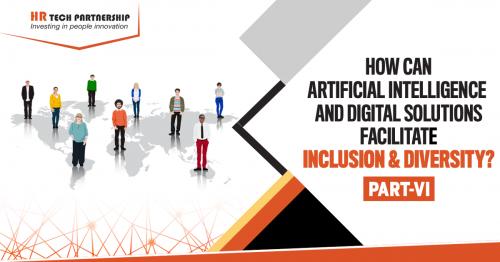How can Artificial Intelligence and Digital Solutions facilitate inclusion and diversity?

A blog by Gabriel Barnes
In previous blogs in this series, we have seen how the coronavirus crisis has caused significant disruption for companies at all levels. However, the shift to remote working has brought some unexpected yet valuable benefits for the inclusion and diversity (I&D) agenda – at a time when leaders are feeling increased pressure to demonstrate how they are delivering workplace equality and ensure that everybody is treated fairly at work, regardless of identity or background.
Now that job applicants are able to work full-time from home, the talent pool for employers has become wider and deeper, and therefore significantly more diverse. In addition, certain groups of people whose engagement has traditionally been unfairly hampered – such as working parents – have been able to cultivate a more effective work-life balance, fostering inclusion in the workplace. The crisis has also shown that the most successful leadership is that which is empathetic – so inclusive and understanding.
Artificial Intelligence can assist I&D leaders enormously in furthering their essential initiatives, costing a fraction of the price of normal technology in proportion to its capabilities, and with the capacity to personalise content and draw on real-time, predictive data.
How is AI being used already to support inclusion and diversity?
Artificial Intelligence is already being used to support HR teams to ensure that I&D is at the heart of their day-to-day work. Companies are using advanced digital tools to identify and investigate which unconscious biases might be affecting key processes, such as performance appraisals, adversely affecting the employee. This is an example of essential work that Artificial Intelligence is capable of doing quickly and thoroughly – involving information gathering and analysis that would be almost impossible for a human to undertake.
Just as importantly, the rise in the use of more simple digital tools, such as Zoom and Microsoft Teams, which now are the facilitators behind nearly all work that takes place remotely, is also ensuring the inclusivity of the workplace. This digitalisation of interactions has eradicated the exclusive – and therefore potentially harmful – banter that used to take place before an in-person meeting. It has also promoted more effective co-operation between individuals who may not have worked together all that much in the past.
The future of Artificial Intelligence in inclusion and diversity
Currently, digital tools are being used mainly to support the recruitment and talent acquisition process – helping to remove bias that might be present in a job advert, attracting a more diverse pool of candidates, performing tasks such as CV screening, and supporting the interview process – all the while ensuring that equalities are the driving force behind this work. In the future however, the extent to which Artificial Intelligence will be used to facilitate I&D is set only to increase.
- In the wake of the pandemic, more and more organisations will be looking to digital tools that can support them through periods of restructuring – or ‘agile workforce planning’. This will ensure that people selection will be done and pay decisions will be made most fairly.
- Talent acquisition is going to rely more heavily on Artificial Intelligence more generally, especially as workforces become increasingly dispersed, promoting inclusion.
- Training around I&D is predicted to become almost entirely digitalised. Expensive classroom-based training will be replaced by learning tools based in Artificial Intelligence – whether it is a WhatsApp-based programme which uses machine learning to deliver this training to dispersed workforces, or Virtual Reality simulations for advanced leadership coaching.
- As bodies of employees become more diverse and dispersed, coaching will no doubt become more of a challenge and Artificial Intelligence will help to address this – with the use of chatbots and gamification to encourage engagement.
- Digital tools will also be able to ensure that leadership selection is done efficiently and fairly – which will serve to promote inclusion and diversity among the most senior of staff. Data harnessed from Organisation Network Analysis from online interactions – such as email – can provide insights into who within a team are the influencers, and therefore the potential leaders of the future.
It goes without saying that I&D should be a priority for all organisations, and Artificial Intelligence can facilitate these initiatives by, for example, eradicating bias in the HR function, in a very cost-effective way. The moral justification for investments in this area is self-evident.
However, it is also necessary to demonstrate the potential for a high Return on Investment which makes implementing these digital solutions a worthwhile approach to furthering I&D initiatives.
A useful low-risk way to test the applications of digital solutions is to pilot them initially, conducting a trial in a small team or around a specific issue, before scaling up if successful.
The HR Tech Partnership (HRTP) runs a human capital digital innovation hub which can facilitate this low-budget innovation in HR so that leaders do not have to make large commitments in the first instance.
Originally published at https://www.hrtechpartnership.com
Post Your Ad Here
Comments